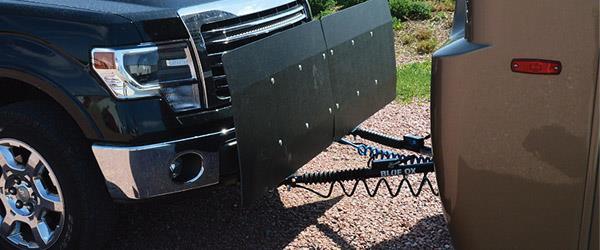
Things to Know... Before You Flat Tow!
It's almost that time of the year again. Time to fly south and enjoy some much-needed TLC and escape the harsh Northern winters. One question you should ask yourself is, are you going to bringing a secondary vehicle with you to your Southern escape (if you're driving your RV down that is!) Here are 6 guidelines to consider and double-check if you're looking into towing your commuter car behind your home away!
1.) Ensure the vehicle you’re looking to tow is approved by the manufacturer (Dodge, Chevrolet, Toyota, Honda, etc.) for flat towing, check out Motorhome Magazine’s towing guide for more information. This will ensure your car can be towed via a Tow Bar and Base Plate system without voiding any warranties. Consult your owner’s manual for clarification on this. Vehicles that are not pre-approved for flat towing can still be transported with modification to the vehicle (we strongly recommend any aftermarket configuration with a service professional to ensure no permanent damage will be made to your Towed Vehicle or RV), most vehicles cannot be flat towed due to transmission issues, where the transmission will engage and overheat while being towed. Remco has a pumping system that allows the fluid to circulate to the transmission fluid, to keep everything lubricated and cooled while towing. (Again, we cannot stress this enough: please contact service professionals before implementing any changes like this.) If you don’t want to make permanent changes to the vehicle, there alternate towing methods.
2.) The second thing you’ll want to do is confirm your Motorhome/RV's tow limit to ensure that the towed vehicle you plan on taking is within this weight in order to avoid damage to the chassis and accidents.
3.) You’ll want to also verify the weight rating of your Hitch Receiver. Estimate your planned tow weight of the vehicle + Cargo. You’ll want to account for the heaviest possible load that you will be carrying to ensure there is no breakage or damage to the tow system or the RV itself. GVWR (Gross Vehicle Weight Rating) is the total maximum weight capacity of a loaded vehicle. GCWR (Gross Combination Weight Rating) is the total allowable weight of the motorized vehicle and any vehicle it is towing. Subtracting the former from the latter is the best way of getting the maximum weight of a trailer or towed car that can be towed by the tractor vehicle.
4.) Most Tow Bars will require you to install a Drop Receiver to the existing Hitch Receiver in order to provide a level connection between mount and tow bar. Do not weld the hitch receiver and drop receiver together as this could cause complication (not to mention a royal pain in you know where if you ever want to switch up you're set-up/ sell your Motorhome) we recommend utilizing at minimum grade 5 bolts, washers, locking nuts and threads.
5.) The next thing you’ll be considering is a proper Tow Bar. There are two general types of Tow Bars – both are good conditions considering what your budget is and how much functionality you would like:
- An A-Frame Style Tow Bar is the most economical option of the two but provides fewer options when it comes to vehicles able to be towed., because only a limited number of base plates are available for this style. A-Frame Tow Bars also require much more space when storage is considered. Typically, alignment with A-Frame tow bars is a two-person job.
- Self-aligning – Definitely the most popular and versatile of the two options due to the fact they are adaptable to thousands of baseplates manufactured for specific vehicle types. When not in use they take up much less room than their larger/bulkier alternate option and can be set up with one person.

6.) Base plates are the last, but definitely the most intricate of the flat towing process. In order to install one of these puppies a little bit of technical know-how and patience are a must; if you have even an inkling of hesitation we recommend hiring a professional to install for you. For more information on finding the right base plate check this article. In most cases, with a little bit of technical & mechanical know-how and some spare time you can install a base plate system on your own. Please bare in mind that installation often does require some vehicle modification, please consult the manufacturer's installation documentation before buying any product!
